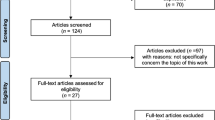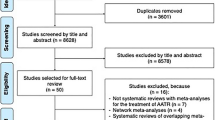Abstract
Introduction
Traumatic tendon lacerations are a common problem encountered by hand surgeons worldwide. Although the use of barbed suture to repair tendon lacerations has gained theoretical popularity in recent years, there is little information available regarding the safety, efficacy, longevity, or complications encountered when used in tenorraphy. In this study, we review the available literature on the use of barbed suture in tendon repair.
Methods
Studies conducted between 1980 and 2014 were identified using several databases, including EMBASE, SCOPUS, MEDLINE, and Web of Science. Keywords used to search for appropriate studies included the following: barbed, v loc, quill, tendon, tendon injuries, suture, tenorraphy, injury, and laceration, in various combinations.
Results
Our initial literature search identified 47 articles, and 8 were deemed appropriate for review after applying our exclusion criteria. The data from each of the articles is reviewed for the following major categories:
-
1.
Maximum load to failure
-
2.
Mode of failure
-
3.
Load to 2-mm gap
-
4.
Change in cross-sectional area
-
5.
Type of repair
Conclusions
Barbed suture tenorraphy has a myriad of theoretical advantages, supported by varying ex vivo studies, as compared to traditional techniques. However, due to the non-uniformity in current studies and the lack of available data in a live model, we are unable to argue for or against barbed suture tenorraphy. We believe our review provides the most in-depth analysis of barbed suture tenorraphy to date, illuminates the potential advantages of using barbed sutures, and highlights the need for further investigation into this technique.







Similar content being viewed by others
References
Ansari U, Lawson RD, Peterson JL, Appleyard RC, Tonkin MA. Effect of partial versus complete circumferential repair on flexor tendon strength in cadavers. J Hand Surg. 2009;34:1771–6.
Aoki M, Manske PR, Pruitt DL, Larson BJ. Work of flexion after tendon repair with various suture methods. A human cadaveric study. J Hand Surg. 1995;20:310–3.
Barrie KA, Wolfe SW, Shean C, Shenbagamurthi D, Slade 3rd JF, Panjabi MM. A biomechanical comparison of multistrand flexor tendon repairs using an in situ testing model. J Hand Surg. 2000;25:499–506.
Cannon NM, Strickland JW. Therapy following flexor tendon surgery. Hand Clin. 1985;1:147–65.
Caulfield RH, Maleki-Tabrizi A, Patel H, Coldham F, Mee S, Nanchahal J. Comparison of zones 1 to 4 flexor tendon repairs using absorbable and unabsorbable four-strand core sutures. J Hand Surg Eur Vol. 2008;33:412–7.
Coert JH, Uchiyama S, Amadio PC, Berglund LJ, An KN. Flexor tendon-pulley interaction after tendon repair. A biomechanical study. J Hand Surg. 1995;20:573–7.
Cooney WP, Weidman K, Malo D, Wood MB. Management of acute flexor tendon injury in the hand. Instr Course Lect. 1985;34:373–81.
Gussous YM, Zhao C, Amadio PC, An KN. The resurgence of barbed suture and connecting devices for use in flexor tendon tenorrhaphy. Hand. 2011;6:268–75.
Hirpara KM, Sullivan PJ, O’Sullivan ME. A new barbed device for repair of flexor tendons. J Bone Joint Surg Br Vol. 2010;92:1165–70.
Ingle NP, King MW. Optimizing the tissue anchoring performance of barbed sutures in skin and tendon tissues. J Biomech. 2010;43:302–9.
Ingle NP, King MW, Zikry MA. Finite element analysis of barbed sutures in skin and tendon tissues. J Biomech. 2010;43:879–86.
Jennings ER, Mansberger Jr AR, Smith Jr EP, Yeager GH. A new technique in primary tendon repair. Surg Gynecol Obstet. 1952;95:597–600.
Joyce CW, Whately KE, Chan JC, Murphy M, O’Brien FJ, Carroll SM. Flexor tendon repair: a comparative study between a knotless barbed suture repair and a traditional four-strand monofilament suture repair. J Hand Surg Eur Vol. 2014;39:40–5.
Khanna A, Gougoulias N, Maffulli N. Modalities in prevention of flexor tendon adhesion in the hand: what have we achieved so far? Acta Orthop Belg. 2009;75:433–44.
Kim PT, Aoki M, Tokita F, Ishii S. Tensile strength of cross-stitch epitenon suture. J Hand Surg. 1996;21:821–3.
Kim JC, Lee YK, Lim BS, Rhee SH, Yang HC. Comparison of tensile and knot security properties of surgical sutures. J Mater Sci Mater Med. 2007;18:2363–9.
Kubota H, Aoki M, Pruitt DL, Manske PR. Mechanical properties of various circumferential tendon suture techniques. J Hand Surg. 1996;21:474–80.
Lin TE, Lakhiani C, Lee MR, Saint-Cyr M, Sammer DM. Biomechanical analysis of knotless flexor tendon repair using large-diameter unidirection barbed suture. Hand. 2013;8:315–9.
Marin Braun F, Foucher G, Buch Jaeger N, Sammut D. [Repair of the flexor digitorum profundus and the flexor pollicis longus by the “rope down” technique. Results in a series of 77 cases]. Ann Hand Upper Limb Surg. 1991;10:13–21.
Marrero-Amadeo IC, Chauhan A, Warden SJ, Merrell GA. Flexor tendon repair with a knotless barbed suture: a comparative biomechanical study. J Hand Surg. 2011;36:1204–8.
McClellan WT, Schessler MJ, Ruch DS, Levin LS, Goldner RD. A knotless flexor tendon repair technique using a bidirectional barbed suture: an ex vivo comparison of three methods. Plast Reconstr Surg. 2011;128:322e–7e.
McKenzie AR. An experimental multiple barbed suture for the long flexor tendons of the palm and fingers. Preliminary report. J Bone Joint Surg Br Vol. 1967;49:440–7.
Miller B, Dodds SD, de Mars A, Zagoreas N, Waitayawinyu T, Trumble TE. Flexor tendon repairs: the impact of fiberwire on grasping and locking core sutures. J Hand Surg. 2007;32:591–6.
Momose T, Amadio PC, Zhao C, Zobitz ME, Couvreur PJ, An KN. Suture techniques with high breaking strength and low gliding resistance: experiments in the dog flexor digitorum profundus tendon. Acta Orthop Scand. 2001;72:635–41.
Momose T, Amadio PC, Zhao C, Zobitz ME, An KN. The effect of knot location, suture material, and suture size on the gliding resistance of flexor tendons. J Biomed Mater Res. 2000;53:806–11.
Moriya T, Zhao C, An KN, Amadio PC. The effect of epitendinous suture technique on gliding resistance during cyclic motion after flexor tendon repair: a cadaveric study. J Hand Surg. 2010;35:552–8.
Murtha AP, Kaplan AL, Paglia MJ, Mills BB, Feldstein ML, Ruff GL. Evaluation of a novel technique for wound closure using a barbed suture. Plast Reconstr Surg. 2006;117:1769–80.
O’Broin ES, Earley MJ, Smyth H, Hooper AC. Absorbable sutures in tendon repair. A comparison of PDS with prolene in rabbit tendon repair. J Hand Surg. 1995;20:505–8.
Parikh PM, Davison SP, Higgins JP. Barbed suture tenorrhaphy: an ex vivo biomechanical analysis. Plast Reconstr Surg. 2009;124:1551–8.
Peltz TS, Haddad R, Scougall PJ, Gianoutsos MP, Bertollo N, Walsh WR. Performance of a knotless four-strand flexor tendon repair with a unidirectional barbed suture device: a dynamic ex vivo comparison. The Journal of hand surgery, European volume 2014;39:30-9.
Peltz TS, Scougall P, Oliver RS, Glanoutsos MP, Bertollo N, Walsh W. The knotless tendon repair with a resorbable unidirectional barbed suture device: an in vivo comparison in the turkey foot. J Hand Surg. 2013;38:e33–4.
Pruitt DL, Aoki M, Manske PR. Effect of suture knot location on tensile strength after flexor tendon repair. J Hand Surg. 1996;21:969–73.
Thurman RT, Trumble TE, Hanel DP, Tencer AF, Kiser PK. Two-, four-, and six-strand zone II flexor tendon repairs: an in situ biomechanical comparison using a cadaver model. J Hand Surg. 1998;23:261–5.
Trail IA, Powell ES, Noble J. An evaluation of suture materials used in tendon surgery. J Hand Surg. 1989;14:422–7.
Trocchia AM, Aho HN, Sobol G. A re-exploration of the use of barbed sutures in flexor tendon repairs. Orthopedics 2009;32.
Viinikainen A, Goransson H, Huovinen K, Kellomaki M, Rokkanen P. A comparative analysis of the biomechanical behaviour of five flexor tendon core sutures. J Hand Surg. 2004;29:536–43.
Waitayawinyu T, Martineau PA, Luria S, Hanel DP, Trumble TE. Comparative biomechanic study of flexor tendon repair using FiberWire. J Hand Surg. 2008;33:701–8.
Winters SC, Gelberman RH, Woo SL, Chan SS, Grewal R, Seiler 3rd JG. The effects of multiple-strand suture methods on the strength and excursion of repaired intrasynovial flexor tendons: a biomechanical study in dogs. J Hand Surg. 1998;23:97–104.
Zeplin PH, Zahn RK, Meffert RH, Schmidt K. Biomechanical evaluation of flexor tendon repair using barbed suture material: a comparative ex vivo study. J Hand Surg. 2011;36:446–9.
Conflict of Interest
AS declares that he has no conflict of interest.
MR declares that she has no conflict of interest.
AA declares that he has no conflict of interest.
Statement of Human and Animal Rights
This article does not contain any studies with human or animal subjects.
Statement of Informed Consent
Informed consent is not necessary in this study as it is a review of the available literature on the topic.
Support
None
Financial Disclosures
All authors have no commercial associations or disclosures that may pose or create a conflict of interest with the information presented within this manuscript.
Author information
Authors and Affiliations
Corresponding author
About this article
Cite this article
Shah, A., Rowlands, M. & Au, A. Barbed Sutures and Tendon Repair—a Review. HAND 10, 6–15 (2015). https://doi.org/10.1007/s11552-014-9669-z
Published:
Issue Date:
DOI: https://doi.org/10.1007/s11552-014-9669-z




